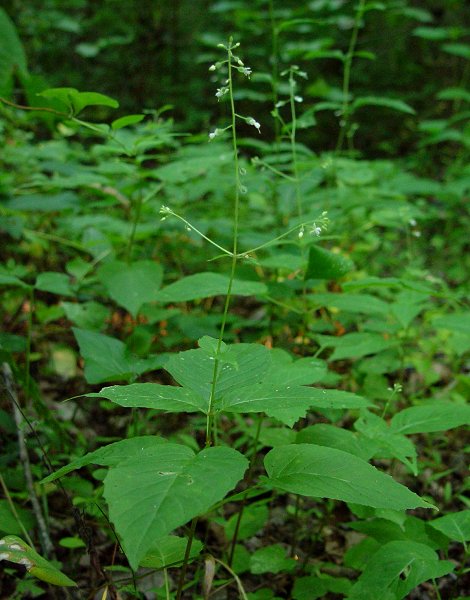Circaea canadensis (L.) Hill
Enchanter's Nightshade

Native
CC = 2
CW = 3
MOC = 67
© DETenaglia
Circaea canadensis (L.) HillEnchanter's Nightshade | |
 |
Native CC = 2 CW = 3 MOC = 67 |
© DETenaglia |
|
Family - Onagraceae Habit - Perennial forb, with long basal stolons. Stems - Strongly ascending to erect, to 90 cm, simple or rarely branched, glabrous toward the base, sparsely pubescent with short, glandular hairs toward the tip. Leaves - Opposite, simple, petiolate. Petioles 2.5-5.5 cm long, mostly glabrous or with a few antrorse hairs, with a thin shallow adaxial groove. Stipules minute, glandular, usually promptly deciduous. Blades 5-16 cm long, 2.5-5.5 cm broad, ovate, rounded to shallowly cordate at the base, acute, the margins finely toothed, the surfaces minutely glandular-hairy to nearly glabrous. Marginal teeth with a minute whitish apex.
Inflorescence - Loose, terminal racemes, these often grouped into open, few-branched panicles, the axis 2.5-30 cm long, glandular-hairy. Each pedicel sometimes subtended by a minute subulate bract to 1.5 mm long.
Flowers - Strongly zygomorphic, opening during the day; the stalk 2.5-6.5 mm long, spreading at flowering, reflexed or downward-curved at fruiting. Floral tube 0.7-1.2 mm long, funnelform. Sepals 2, 1.9-3.8 mm long, 1.2-2.4 mm wide, very broadly elliptic, oblong, or oblong-ovate, green or purple, spreading to reflexed at flowering. Petals 2, 1.6-2.9 mm long, 2.2-4.0 mm wide, alternating with sepals, usually white, broadly ovate-triangular to broadly obovate or heart-shaped; with apical notch 1/3 to slightly more than 1/2 the length, glabrous. Stamens 2; the filaments white, glabrous, 1.2-2.8 mm long. Ovary 2-locular, the style 2.5-5.5 mm long, glabrous, basally surrounded by a green nectary, to 4 mm long. Stigma entire or shallowly 2-lobed, capitate. Ovary inferior, densely covered with uncinate hairs, to 2 mm long in flower, green.
Fruits - Capsules, indehiscent, burlike, 2.8-4.5 mm long, 1.9-3.6 mm wide, pear-shaped to subglobose, rounded at the tip, tapered obliquely at the base, the surface longitudinally ribbed, with short, dense, hooked hairs. Seeds 2, adhering to inner ovary wall, lacking an apical tuft of hairs.
Flowering - June - August. Habitat - Bottomland and mesic forests, bluff bases. Origin - Native to U.S. Lookalikes - None close. Other info. - This small but common species can be found throughout Missouri. Its U.S. distribution includes most of the eastern half of the country, and it also extends into Canada. It is easy to identify by virtue of its opposite leaves and small, bright white flowers. A close look at the flowers shows interesting detail and densely hairy ovaries just behind the corolla parts. The plant prefers rich, moist wooded areas and can sometimes be found in large colonies. Photographs taken in Brown Summit, NC., 6-16-02 (DETenaglia); also along the Duckett Creek trail, St. Charles County, MO, 6-18-2012, and near Aetna, MI, 6-30-2014 (SRTurner). |